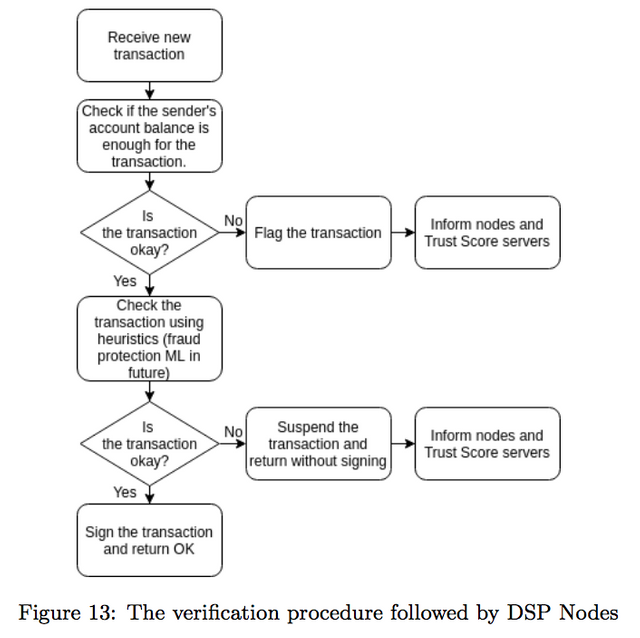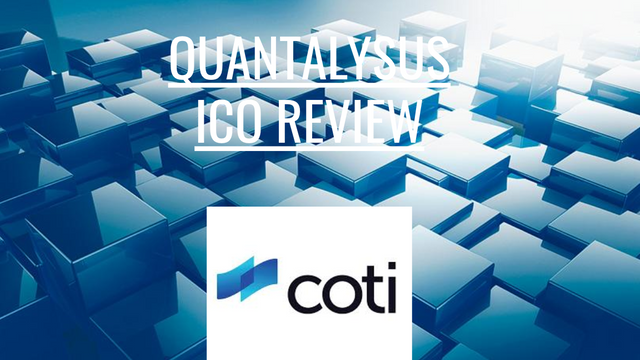ICO Review: COTI (Outlook: Pass)
Check out our new ICO ranking spreadsheet where we keep track of every project we review. For ICOs you want queued please click on the Suggestion Link. Also, feel free to discuss technology with us on Telegram.
COTI (Currency Of The Internet) aims to develop a decentralized form of money via its decentralized protocol. Instead of using a blockchain as its primary data structure, COTI is designing a Directed Acyclic Graph (DAG) based ledger. Other projects using a DAG are Fantom, ByteBall, and IOTA. Where blockchains are slow and expensive, COTI promises to deliver a fast and inexpensive method of transactions. This article will dive into DAGs briefly in the context of how it compares to blockchain but I will later release a deep dive into them as an Education Series article. More and more projects are moving away from blockchain structures so it seems prudent to highlight DAGs as a class of projects all unto itself.
Team
- Shahaf Bar-Geffen, CEO: serial entrepreneur and founded several media companeis such as WEB3, Positive Mobile, and Maple. I have not heard of these companies but it appears he is juggling all of these companies at once. His track record revolves around marketing and advertising. I would look to his team for the technological talent needed to execute such an ambitious vision.
- LinkedIn employee counts may understate the size of these companies FYI:
- Maple has 22 employees
- WEB3 has 51 employees
- Positive Mobile has 36 employees
- LinkedIn employee counts may understate the size of these companies FYI:
- Dr. Nir Haloani, CTO: Former experience as a researcher in IBM focused on data compression, data analysis, and pattern recognition. Currently CTO of an AI company called Articoolo Research.
- Erol Hallufgil, Engineer and researcher: 3 years software development working on CRM development, servers and databases. Experience does not scream cutting edge for what COTI is trying to do.
- Tal Dadia, Engineer and researcher: currently a student at IDC Herzliya going for a dual bachelors and masters in law and financial engineering respectively. Skill sets listed as Python, Java, C#, and SQL.
- Yoni Neeman, Engineer and researcher: bachelors of science from Tel Aviv University. Few years experience software development. LinkedIn is really sparse.
- Anton Suslonov, Engineer and researcher: LinkedIn is terribly light except for he graduated from Moscow Institute of Physics and Technology (State University) (MIPT) in 1994 with a degree in Applied Mathematics. His certificates hit all the right machine learning buzzwords. I won't list them here.
The rest of my review is going to be a skim through.
Token Metrics
- Ticker: COTI
- Total supply: 4 billion COTI
- Hard cap: $30M USD
- Allocations: 40% for sale (good), 10% (team, early backer, advisors, bounty hunters), 50% for future development (released gradually to promote network expansion)
- Sale dates: private sale (March 2018), public pre-sale (April 2018),
- Token type: ERC20
Features of the protocol
DAG
DAGs are not new. In fact, several projects such as Byteball, IOTA, dagcoin, and Fantom employ their own variation of a DAG. I list their whitepapers down below. This architecture is different from blockchain in that it was specifically designed for low-value transactions. IoT devices and smart phones appear to be tailor made to utilize these protocols. IOTA calls its design tangle, COTI calls its transactions the cluster. COTI claims its cluster's theoretical throughput will be 10,000 TPS.
When a participant sends a transactions they are required to validate two prior transactions. Once they have completed that validation the transaction will be added to the ledger. Visualizing this schema will show why the term cluster is appropriate.
In the diagram, the white circles represent a transaction that has been validated by two transactions previously. The figure above is taken from the Byteball whitepaper. The red circles indicate a potential double spend attack. In Byteball, a sender must send all of their previous transactions as it may be possible to send two transactions unconnected to each other. COTI attempts to resolve double spend with their Double Spend Nodes.
Trust Chain Algorithm and Trust Score Servers
From their whitepaper, COTI will have a trust or a reputation based system to reach consensus. A machine-learning based algorithm will use historical behavioral data to validate and confirm transactions. This high level of trust will enable faster transactions. Every account is incentivized to earn a higher trust score. Having a low trust score is equivalent to a slashing mechanism in Proof-of-Stake based systems. Once you have a low trust it becomes more difficult to transact on the network, if at all. Trust scores will be hosted on what COTI calls their Trust Score Severs. There will be transaction fees on the network but the higher the Trust Score, the lower the fees to be paid on the network for users.
Double Spend Prevention (DSP) Nodes
DSPs prevent double spending. According to COTI's whitepaper the DSP performs the following tasks:
- Keep a light version of the Cluster with pre-calculated account balances
- Receive a copy of any new transactions attached to the Cluster
- Check new transactions against a set of heuristics to detect possible double-spending attempts
- Check new transactions against available account balances
- Sign legitimate transactions
- Flag transactions suspected of double-spending
- Inform Trust Score Servers about double-spending attempts.

To host a DSP Node you must pass KYC/AML procedures and essentially stake a substantial amount of COTI (over 10,000 COTI) in a multisig wallet.
Full Nodes
In addition to the DSP Nodes, there is the option to run a Full Node (FN). These FNs collect transaction fees. A portion of these fees will go to the COTI network to fund infrastructural support of the DSP and Trust Score Servers. Fees are set by the FNs themselves. The better the service, the higher the fee they can charge the network. A maximum fee will be determined by the network and no minimum fee will be set.
Mediation Service
The Mediation Service will be used as a dispute resolution mechanism. Like, DSP Nodes, Mediators are also network participants with very high Trust Scores. For their services they are rewarded with mediation fees. Mediators essentially act as data oracles where they validate real world information in the case of merchant disputes. This offline mediation then provides an online consensus. Case participants will deposit their COTI funds into an escrow fund service developed and maintained by the COTI development team. Winners of their case will receive COTI transfers from the escrow funds.
Clusterstamp
Preventing the network from growing unmanageably large, COTI introduces what it calls its Clusterstamp. Essentially, the clusterstamp is a method of snapshotting an account's balance and stitched onto the latest unconfirmed transactions in the Cluster. From that point forward that will become the genesis transaction for the next wave of transactions. Think of it as a rolling history of the cluster.
Verdict
This project is a pass for me. They're raising far too much money for a project that has not published their code base. Not only that but the team on paper looks lightweight. Most of the team is working somewhere else concurrently while working on COTI. Is this team dedicated to this project? Again, I relate this to the size of their raise. If you're going to raise $60M perhaps the team should appear fully committed to COTI. This goes for all other projects I look at. Having a very unified and tight knit LinkedIn presence will look credible for your commitment. That's my point of view at least as a professional living in the USA. LinkedIn is part of the culture here for performing due diligence on team backgrounds. If you're a developer, I'd like to see a stronger presence to your GitHub or BitcoinTalk contributions. As of this writing there is no public repo to examine.
Half of all COTI tokens are set aside for future development. Other projects set up a foundation with unbiased participants to determine what to do with reserved funds. Playing devil's advocate here, but what are the mechanics to ensure these tokens are used honestly to develop the ecosystem? What if the project burns through its capital quickly or mismanages its ETH treasury, will the team forcibly reallocate its "development fund" to fuel ongoing operations.
The whitepaper's claim of 10,000 TPS seems very reasonable compared to the blustery claims of millions of transactions per second. While the cluster itself is decentralized, the Trust Score Servers and Double Spend Prevention Nodes appear to be points of vulnerability for the network. Another point of weakness would be a coordinated attack on the Full Nodes on the network.
The cumulative growth of a blockchain is a concern when it comes to data storage and latency issues. COTI's clusterstamp approach could work in managing the ledger size by simply removing the history and snapshotting an account's balance. What is lost is the history of that account. In order to go back in history, a lighter node would need some sort of bootstrapping offering from the full nodes.
Overall, the design of COTI relies on too many trusted parties. Double Spend Nodes, Trusted Servers, and Mediation Service providers feature too many centralized points of vulnerability for my taste. I've already commented on the team and the level of the funds they are raising for the stage of development they are at. Lastly, I wished there was some code that was out there for the public to see. With all of this combined, I am going to pass on this opportunity.
Sources
- Anton Churyumov, Byteball: A decentralized system for storage and transfer of value
- Serguiei Popov, The Tangle
- Yary Ribero and Daniel Raissar, Dagcoin whitepaper
- Token sale summary
Thank you for coming to the site. Quantalysus publishes blockchain research and analysis for the crypto community. Please follow on Twitter, Steem (please follow and upvote if you can – thanks!), Telegram channel (New!), and Medium to stay up to date.
If you want to earn Aelf (ELF) tokens for just using Twitter and Reddit, sign up for their candy / bounty program.
If you learned something:
- Please consider donating to keep this website up and running
- Earn Aelf tokens by following them on Twitter (my referral link)
- Follow me on Steem (@quantalysus). I appreciate upvotes!
- Follow me on Twitter (@CryptoQuantalys)
- Education Series: Why we need Bitcoin
- Education Series: The History of Bitcoin
- Education Series: How do ICOs work
- Education Series: Hash Functions
- Education Series: Sybil Attacks
- Education Series: Airdrops
- Education Series: Byzantine General’s Problem
- Education Series: Regulation A and D
- ICO Review: Taraxa (Part 1)
- ICO Review: Arweave
- ICO Review: Lightstreams
- ICO Review: Hypernet
- ICO Review: Hero Node
- ICO Review: Solana
- ICO Review: Phantasma
- ICO Review: Holochain
- ICO Review: Edenchain
- ICO Review: Quarkchain
- ICO Review: DAOStack
- ICO Review: Alchemint
- ICO Review: Loki Network
- Coin Review: Nexo
- Coin Review: Ontology
- Coin Review: Aelf
- Coin Review: Mithril
- Coin Review: Qtum
- Coin Review: Waves
- Coin Review: Banyan Network (BBN)
- Opinion: Token economics
- Opinion: ICO paradox
- Opinion: Why we love Steem
- Analysis: Starkware Industries
- Analysis: If Steem were a country, it would be the most unequal society


